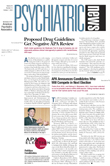I am writing this column in the midst of congressional hearings that are bracketing a recent Food and Drug Administration (FDA) advisory committee meeting, all focused on the association of suicidal behaviors with the use of SSRIs by children and adolescents. This issue is of immense concern to parents, our young patients, and to ourselves as clinicians and researchers. At this moment, it appears that the FDA will be advised by its committee to mandate a black box warning on SSRIs in response to data that point to an approximate doubling of the risk of low-prevalence suicidal behaviors among a small proportion of adolescents for whom these medications have been prescribed.
Lost in the hue and cry over risks linked to SSRI use by adolescents is another story the data tell, which document the unequivocal effectiveness of these medications in treating a debilitating and intrinsically life-threatening disorder affecting between 3 percent and 5 percent of American children and adolescents.
In this column, I want to review information compiled by our APA Office of Research staff and colleagues in the field that has begun to crystallize what we know, what we don't know, and what we must do, clinically and scientifically, to ensure the health and safety of children and adolescents with a depressive disorder.
Data sources for our APA review included first-stage results of the NIMH-sponsored Treatments for Adolescents With Depression Study (TADS), which reported on 12-week trials of fluoxetine, fluoxetine plus CBT, CBT alone, and placebo in 439 youth with moderate to severe depression (Psychiatric News, September 3). We also drew on two meta-analyses conducted by and for the FDA of clinical trials involving 4,555 adolescents receiving any of eight SSRIs for treatment of depression.
We know that suicidal behaviors are an all-too-frequent concomitant of major depressive disorder. In the TADS study, for example, 29 percent of adolescents with moderate to severe depression experienced clinically significant suicidal ideation prior to treatment.
These risks are best understood in an overall population-based context of suicidal behaviors among youth. One source of such data is Madelyn Gould and colleagues' report of the NIMH-sponsored Methods for the Epidemiology of Child and Adolescent Mental Disorders study of community samples of about 1,300 youth aged 9 to 17; 7.5 percent of respondents reported suicidal ideation in the previous six months, 3.3 percent reported a suicide attempt in their lifetime, and 1.6 percent reported a suicide attempt in the previous six months. Of those reporting lifetime suicide attempts, 37.5 had a diagnosis of major depressive disorder, and of those reporting suicidal ideation, 23.3 percent were diagnosed with major depressive disorder.
We also now have consistent evidence of some elevated risk of suicidal behaviors among a small proportion of adolescents receiving SSRIs. In the TADS study, there were no completed suicides but seven attempts (1.5 percent of the sample); among an additional 5 percent of subjects who experienced a“ suicide-related event,” differences between those receiving fluoxetine and those on CBT or placebo were not statistically significant.
In the FDA meta-analyses, researchers found that 33 subjects (1.7 percent of the aggregate population) experienced suicidal ideation; again, there were no completed suicides.
Findings that active medication was associated with approximately a doubling of the risk of suicidal events demand our attention, but must not obscure the indisputable evidence of SSRIs' efficacy in treating adolescent depression, including suicidality. Over the 12 weeks reported for the TADS study, 71 percent of the patients responded positively to the combination of fluoxetine and CBT, a response rate double that for patients on placebo. The response rate for study participants taking fluoxetine alone was 60.9 percent, and among those who received only CBT, the response rate was 43.2 percent.
Suicidal ideation among subjects dropped dramatically, from 29 percent at baseline to less than 10 percent at week 12.
We do not know with certainty the factors associated with suicidal behaviors in a small group of patients in the TADS study. Future analyses will need to examine these events and their timing in relation to exposure to medications and to other medical conditions that could increase impulsivity, such as ADHD or substance abuse, or adverse life events. Nor do we know why some 30 percent of young patients in the TADS study did not improve on the best treatment regimen, that is, fluoxetine plus CBT.
Absolute safety concerns may have fostered a rush to judgment on the use of SSRIs with young patients in some other countries. We need to be aware and educate others that the benefits of these treatments—the alleviation of suicidality in the vast majority and their potency in addressing the multiple social, academic, and health-related disabilities of depression—must be given careful consideration when assessing the potential risk associated with their use.
We know that when young patients receive these medications, careful monitoring is imperative, especially early in treatment. And we know that those who do not respond to fluoxetine, which the evidence suggests to be a reasonable first-line treatment, underscore the need for a range of medications and psychotherapeutic interventions that are responsive to the unique characteristics of individual patients. Further research is needed to address treatment-resistant depression, including examinations of the unique genetic risk and metabolic characteristics of adolescents with subtypes of major depression.
Finally, these reports coincide with continuing calls for a national clinical trials registry, an area in which APA has exercised a leading voice. I will address the implications of this development for clinical practice and science in a future column. ▪

